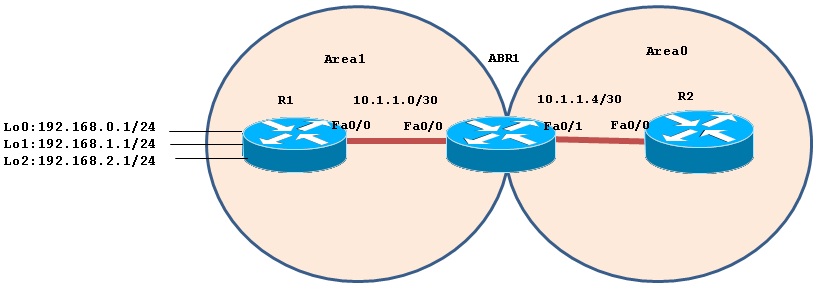- Cisco Community
- Technology and Support
- Networking
- Networking Knowledge Base
- OSPF Inter-area route summarization
- Subscribe to RSS Feed
- Mark as New
- Mark as Read
- Bookmark
- Subscribe
- Printer Friendly Page
- Report Inappropriate Content
- Subscribe to RSS Feed
- Mark as New
- Mark as Read
- Bookmark
- Subscribe
- Printer Friendly Page
- Report Inappropriate Content
10-26-2012 12:24 AM - edited 03-01-2019 04:51 PM
Introduction:
OSPF is link state routing protocol that works on the concept of areas. All areas must have same LSDB (link state database); hence OSPF summarization can only done on the border routers i.e. on ABR (Area border router) and ASBR (Autonomous system boundary router).In this document we discussed about route summarization between the areas.
Background:
Summarization between areas can be done on ABR by using single command under OSPF process:
area [area-id] range [ ip-address ] [mask ] [advertise | not-advertise |cost {cost}]
A) area-id= Identifier of the area about which routes are to be summarized
B) [ ip-address ] [mask]= Summary route to be advertise in areas
Summary route calculation:
Only 3 steps are required to calculate summary route
1) Convert the addresses to binary format
2) Locate the bit where the common pattern of digits ends
3) The number of common bits is subnet mask and the summary route number is represented by the first IP address in the block.
Let’s assume the following networks in routing table:
192.168.0.0/24
192.168.1.0/24
192.168.2.0/24
Prefix’s | Binary Splitting |
| 8 16 24 32 |
192.168.0.0 | 11000000 10101000 0000 0000 000000000 |
192.168.1.0 | 11000000 10101000 0000 0001 000000000 |
192.168.2.0 | 11000000 10101000 0000 0010 000000000 |
From the above table it shows first 22 bits are common, so summary route subnet mask is /22 i.e. 255.255.252.0 and summarized route is 192.168.0.0/22
C) advertise = By default type 3 LSA is advertise
D) not-advertise =Its optional and used to filter type 3 LSA component of the networks specify in range command.
E) Cost =It’s optional When we have multiple ABRs we can Advertise summary route with cost for route manipulation.
Configuration overview:
In following example router ABR1 is directly connected to R1 in area 1 and to R2 in backbone area0.
Topology Diagram:

On R1 loopbacks are created loopbacks for generating network prefixes and advertise them into OSPF as follow:
R1#sh ip interface brief | include Lo
Loopback0 192.168.0.1 YES manual up up
Loopback1 192.168.1.1 YES manual up up
Loopback2 192.168.2.1 YES manual up up
R2 in area 0 learns Type3 LSA for loopbacks created on R1 via ABR1 and installed into routing table as shown in below output:
R2#sh ip ospf database | Beg Summary
Summary Net Link States (Area 0)
Link ID ADV Router Age Seq# Checksum
10.1.1.0 10.1.1.6 260 0x80000001 0x00B463
192.168.0.0 10.1.1.6 102 0x80000001 0x00B8FD
192.168.1.0 10.1.1.6 102 0x80000001 0x00AD08
192.168.2.0 10.1.1.6 102 0x80000001 0x00A212
R2#sh ip ospf database summary 192.168.0.0
OSPF Router with ID (10.1.1.5) (Process ID 100)
Summary Net Link States (Area 0)
Routing Bit Set on this LSA
LS age: 7
Options: (No TOS-capability, DC, Upward)
LS Type: Summary Links(Network)
Link State ID: 192.168.0.0 (summary Network Number)
Advertising Router: 10.1.1.6
LS Seq Number: 80000002
Checksum: 0x5C62
Length: 28
Network Mask: /24
TOS: 0 Metric: 2
R2#sh ip route | Begin Gateway
Gateway of last resort is not set
10.0.0.0/30 is subnetted, 2 subnets
O IA 10.1.1.0 [110/2] via 10.1.1.6, 00:00:36, FastEthernet0/0
C 10.1.1.4 is directly connected, FastEthernet0/0
O IA 192.168.0.0/24 [110/3] via 10.1.1.6, 00:00:36, FastEthernet0/0
O IA 192.168.1.0/24 [110/3] via 10.1.1.6, 00:00:36, FastEthernet0/0
O IA 192.168.2.0/24 [110/3] via 10.1.1.6, 00:00:36, FastEthernet0/0
Configuring ABR1 to summarized loopback subnets available on R1 i.e.
192.168.0.0/24
192.168.1.0/24
192.168.2.0/24
ABR1(config)#router ospf 100
ABR1(config-router)#area 1 range 192.168.0.0 255.255.252.0
ABR1(config-router)#end
After configuring summarization on ABR1, R2 receives Type 3 i.e.192.168.0.0/22 not individual type 3 LSA for each loopback address from ABR1 shown below:
R2#sh ip route | Begin Gateway
Gateway of last resort is not set
10.0.0.0/30 is subnetted, 2 subnets
O IA 10.1.1.0 [110/2] via 10.1.1.6, 00:16:36, FastEthernet0/0
C 10.1.1.4 is directly connected, FastEthernet0/0
O IA 192.168.0.0/22 [110/3] via 10.1.1.6, 00:06:00, FastEthernet0/0
Discard route:
It's interesting to look at these summary routes on the ABR, which is responsible for doing all of the summarization. The ABR also includes the summary routes, but they aren't real routes, so it simply points them to its Null0 interface called discard routes. They help to prevent routing loops during summarization:
ABR1#sh ip route ospf
O 192.168.0.0/24 [110/2] via 10.1.1.1, 00:15:01, FastEthernet0/0
O 192.168.1.0/24 [110/2] via 10.1.1.1, 00:15:01, FastEthernet0/0
O 192.168.2.0/24 [110/2] via 10.1.1.1, 00:15:01, FastEthernet0/0
O 192.168.0.0/22 is a summary, 00:15:01, Null0
Discard route is generated by default, and you don't need to create it. If you want to disable creation of the discard route, you can use the no discard-route command as follows:
ABR1(config)#router ospf 100
ABR1(config-router)#discard-route internal
ABR1(config-router)#end
Benefits of OSPF Summarization:
1) Reduce the number of routing table entries.
2) Reduce Type3 flooding and saves router CPU resource.
3) Summarization can also be used for route manipulation by using longest match prefix concept
Related Information:
- Mark as Read
- Mark as New
- Bookmark
- Permalink
- Report Inappropriate Content
Hello!
What routing loops are we talking about? Is this the case when the destination address is not included in the /24 but is part of the /22 with the presence of the default route?
Find answers to your questions by entering keywords or phrases in the Search bar above. New here? Use these resources to familiarize yourself with the community: